Creating Your First Java Classes
- Features of the Java Programming Language
- Java Program Types
- Saving a Java Class
- Compiling a Java Class
- Running a Java Class
- Modifying a Java Class
Explanations to week content
Conditional Statements
The if Structure
In Java, the simplest statement you can use to make a decision is the if statement. For example, suppose you have declared an integer variable named quizScore, and you want to display a message when the value of quizScore is 10. The following if statement makes the decision to produce output.
Note that the double equal sign ( == ) isused to determine equality
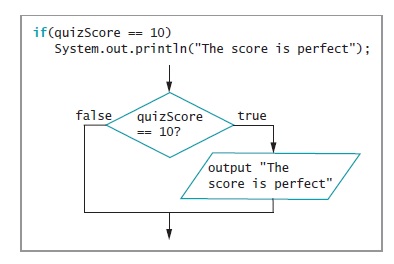
Figure: A Java Flowchart
Relational Operators
| Operator | Meaning |
|---|---|
| == | Equal to |
| != | Not equal to |
| < | Less than |
| <= | Less than or equal to |
| > | Greater than |
| >= | Greater than or equal to |
| || | Or |
| && | And |
The if … else Structure
Consider the following statement:
if(quizScore == 10)
System.out.println("The score is perfect");
Such a statement is sometimes called a single-alternative if because you only perform an action, or not, based on one alternative; in this example, you display a statement when quizScore is 10.Often, you require two options for the course of action following a decision. A dual-alternative if is the decision structure you use when you need to take one or the other of two possible courses of action. For example, you would use a dual-alternative if structure if you wanted to display one message when the value of quizScore is 10 and a different message when it is not.
In Java, the if … else statement provides the mechanism to perform one action when a Boolean expression evaluates as true, and to perform a different action when a Boolean expression evaluates as false.
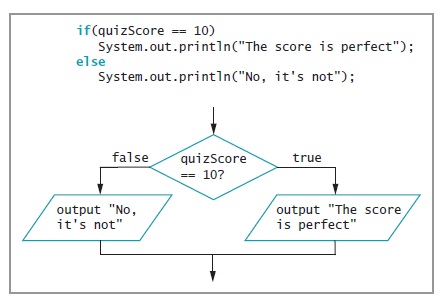
Figure: if … else structure
Example
Write a program which ask the user to enter age. Your program should alert user “You are legible to drink” if the age is 18 or more and “You are not legible to drink” if age is less than 18
Sample Code
import java.util.Scanner;
public class main
{
public static void main(String[] args) {
// TODO Auto-generated method stub
int age;
//Get the age from the user
Scanner inputDevice = new Scanner(System.in);
System.out.println("Please enter your age");
age = inputDevice.nextInt();
inputDevice.nextLine();
if(age>=18){
System.out.println("You are legible to drink");
}else{
System.out.println("You are not legible to drink");
}
}
}
if … else with more than two options
If a decision could be based on more than two options, the following if … else statement is used
if(…){
//option 1 is true
}else if(…){
//option 2 is true
}else if(…){
//option 3 is true
}
.else{
//None of the above options is true
}
Example
The following is the grading system of a school. Write an application to ask a user to enter the score. Your application should then compute the grade and output it to the user.
System
| 80 - 100 | A |
|---|---|
| 75 - 79 | B+ |
| 70 - 74 | B |
| 65 - 69 | C+ |
| 60 - 64 | C |
| 55 - 59 | D+ |
| 50 - 54 | D |
| Below 50 | E |
Sample Code
import
java.util.Scanner;
public class main
{
public static void main(String[] args) {
// TODO Auto-generated method stub
int score;
//Get the age from the user
Scanner inputDevice = new Scanner(System.in);
System.out.println("Please enter your examination score");
score = inputDevice.nextInt();
inputDevice.nextLine();
if(score>=80){
System.out.println("A");
}else if(score>=75){
System.out.println("B+");
}else if(score>=70){
System.out.println("B");
}else if(score>=65){
System.out.println("C+");
}else if(score>=60){
System.out.println("C");
}else if(score>=55){
System.out.println("D+");
}else if(score>=50){
System.out.println("D");
}else{
System.out.println("E");
}
}
}
Nesting if and if … else Statements
Within an if or an else, you can code as many dependent statements as you need, including other if and else structures. Statements in which an if structure is contained inside another if structure are commonly called nested if statements. Nested if statements are particularly useful when two conditions must be met before some action is taken.
Example
For example, suppose you want to pay a Ghc50 bonus to a salesperson only if the salesperson
sells at least three items that total at leastGhc1,000 in value during a specified time. Write a program that ask a salesperson to enter number of items sold and the total amount of the items sold. And inform the salesperson whether qualified for the bonus or not.
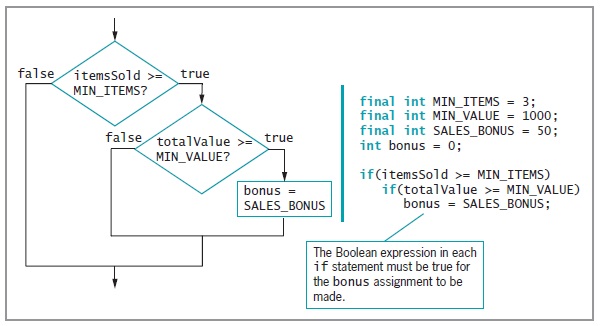
Figure: Determining whether to assign a bonus using nested if statements
import
java.util.Scanner;
public class main
{
public static void main(String[] args) {
// TODO Auto-generated method stub
int items;
final int MIN_ITEMS = 3;
final double MIN_VALUE = 1000;
final double SALES_BONUS = 50;
double amount;
//Get the age from the user
Scanner inputDevice = new Scanner(System.in);
System.out.println("Please enter total items sold");
items = inputDevice.nextInt();
inputDevice.nextLine();
//Check if the person has sold at least 3 items
if(items>=MIN_ITEMS){
//Get the amount of items for the sold items
System.out.println("Please enter the total amount for the sold items");
amount = inputDevice.nextDouble();
inputDevice.nextLine();
//If the amount sold is more then minimum value to sell, give bonus else no bonus
if(amount>=MIN_VALUE){
System.out.println("You have a bonus of GHc "+SALES_BONUS);
}else{
System.out.println("You are not qualified for a bonus");
}
}else{
System.out.println("You are not qualified for a bonus");
}
}
}
Using the switch Statement
By nesting a series of if and else statements, you can choose from any number of alternatives. For example, suppose you want to display a student’s class year based on a stored number.
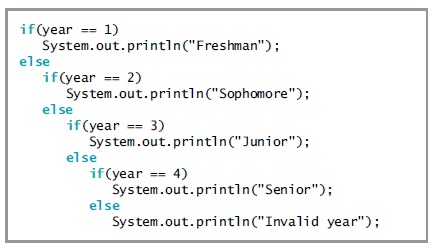
Figure: Determining class status using nested if statements
An alternative to using the series of nested if statements shown in above is to use the switch statement. The switch statement is useful when you need to test a single variable against a series of exactinteger (including int, byte, and short types), character, or string values. The switch structure uses four keywords:
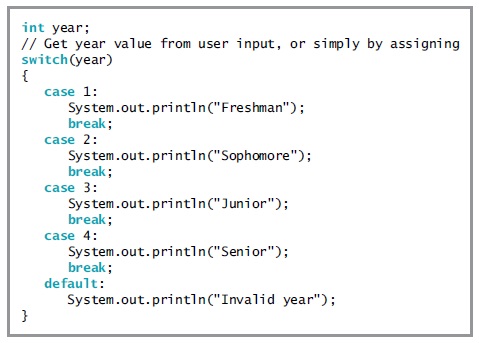
Figure: Determining class status using a switch statement
Assignment
Write a program that asks the user to enter a number. Your program should display to the user whether the number is an even number or odd.
Design:
Enter a number > 3
3 is an odd number